Month View in .NET MAUI Scheduler (SfScheduler)
17 Dec 202523 minutes to read
By default, the Month view displays the entire days of a particular month and current month initially. The current date color is differentiated from other dates of the current month, and also the color differentiation for dates will be applicable for the previous and next month dates.
By default, when an appointment is tried to create through Month view, it is considered to be created for an entire day.
NOTE
The appointment views for each month cells will be updated depends on the month cells height. While resizing the layout, the following actions would be performed,
- If the appointment views overlaps with month cell dates or do not fit into the month cell height then the appointment view is changed from AppointmentDisplayMode.Text to AppointmentDisplayMode.Indicator view.
- If the indicator views overlaps with month cell dates, then the indicator view is changed from (AppointmentDisplayMode.Indicator to AppointmentDisplayMode.None.
Appointment display mode
The scheduler month view appointment display can be handled by using the AppointmentDisplayMode property of MonthView. By default, AppointmentDisplayMode is set to Text, using the AppointmentDisplayMode.
You can set the month view appointments display as follows.
- None: Appointment will not be displayed.
- Indicator: Appointment will be denoted as the circle.
- Text: Appointment subject will be displayed in the month cell.
<scheduler:SfScheduler x:Name="Scheduler"
View="Month">
<scheduler:SfScheduler.MonthView>
<scheduler:SchedulerMonthView
AppointmentDisplayMode="Indicator"/>
</scheduler:SfScheduler.MonthView>
</scheduler:SfScheduler>SfScheduler scheduler = new SfScheduler();
scheduler.View = SchedulerView.Month;
scheduler.MonthView.AppointmentDisplayMode = SchedulerMonthAppointmentDisplayMode.Indicator;
this.Content = scheduler;
NOTE
Appointment indicator count
The scheduler month view appointment indicator count allows you to customize the count of the appointment indicator by using the AppointmentIndicatorCount property of the MonthView. By default, the AppointmentIndicatorCount is set to 5.
<schedule:SfScheduler x:Name="Scheduler"
View="Month" >
<schedule:SfScheduler.MonthView>
<schedule:SchedulerMonthView AppointmentDisplayMode="Indicator"
AppointmentIndicatorCount="2"/>
</schedule:SfScheduler.MonthView>
</schedule:SfScheduler>this.Scheduler.View = SchedulerView.Month;
this.Scheduler.MonthView.AppointmentDisplayMode = SchedulerMonthAppointmentDisplayMode.Indicator;
this.Scheduler.MonthView.AppointmentIndicatorCount = 1;
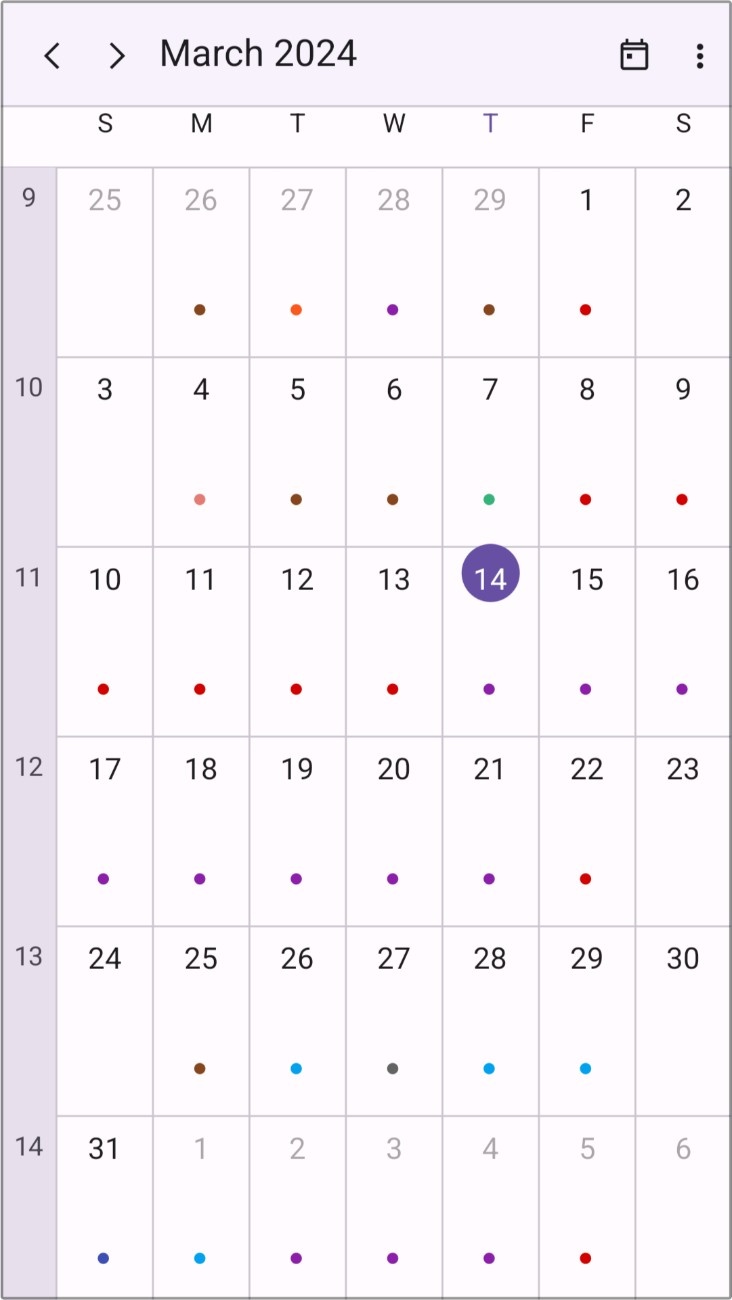
Appointment indicator size
The scheduler month view allows you to customize the size of the appointment indicator by using the AppointmentIndicatorSize property of the MonthView. By default, the AppointmentIndicatorSize is set to 6d.
<schedule:SfScheduler x:Name="Scheduler"
View="Month" >
<schedule:SfScheduler.MonthView>
<schedule:SchedulerMonthView AppointmentDisplayMode="Indicator" AppointmentIndicatorSize="10"/>
</schedule:SfScheduler.MonthView>
</schedule:SfScheduler>this.Scheduler.View = SchedulerView.Month;
this.Scheduler.MonthView.AppointmentDisplayMode = SchedulerMonthAppointmentDisplayMode.Indicator;
this.Scheduler.MonthView.AppointmentIndicatorSize = 10;

Appointment indicator renderer mode
The scheduler month view allows you to customize the appointment indicator rendering mode by using the AppointmentIndicatorRenderMode property of the MonthView. The AppointmentIndicatorRenderMode property supports three different types: Fill, Stroke and FillAndStroke. By default, the AppointmentIndicatorRenderMode is set to Fill.
<schedule:SfScheduler x:Name="Scheduler"
View="Month" >
<schedule:SfScheduler.MonthView>
<schedule:SchedulerMonthView AppointmentIndicatorRenderMode="Stroke" AppointmentDisplayMode="Indicator" AppointmentIndicatorSize="15" AppointmentIndicatorCount="2" />
</schedule:SfScheduler.MonthView>
</schedule:SfScheduler>this.Scheduler.View = SchedulerView.Month;
this.Scheduler.MonthView.AppointmentDisplayMode = SchedulerMonthAppointmentDisplayMode.Indicator;
this.Scheduler.MonthView.AppointmentIndicatorRenderMode = AppointmentIndicatorRenderMode.Stroke;
this.Scheduler.MonthView.AppointmentIndicatorSize = 15;
this.Scheduler.MonthView.AppointmentIndicatorCount = 2;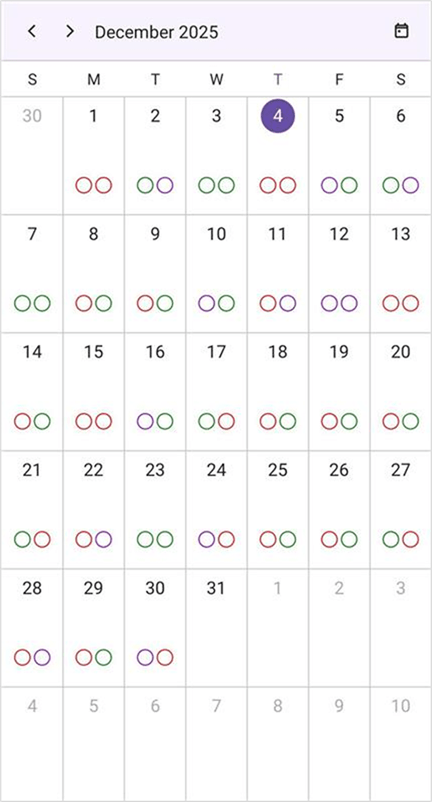
Appointment indicator stroke thickness
The scheduler month view allows you to customize the appointment indicator stroke thickness by using the AppointmentIndicatorStrokeThickness property of the MonthView. By default, the AppointmentIndicatorStrokeThickness is set to 1d.
<schedule:SfScheduler x:Name="Scheduler"
View="Month" >
<schedule:SfScheduler.MonthView>
<schedule:SchedulerMonthView AppointmentIndicatorStrokeThickness="4" AppointmentDisplayMode="Indicator" AppointmentIndicatorSize="20" AppointmentIndicatorRenderMode="Stroke" />
</schedule:SfScheduler.MonthView>
</schedule:SfScheduler>this.Scheduler.View = SchedulerView.Month;
this.Scheduler.MonthView.AppointmentDisplayMode = SchedulerMonthAppointmentDisplayMode.Indicator;
this.Scheduler.MonthView.AppointmentIndicatorRenderMode = AppointmentIndicatorRenderMode.Stroke;
this.Scheduler.MonthView.AppointmentIndicatorSize = 20;
this.Scheduler.MonthView.AppointmentIndicatorStrokeThickness = 4;
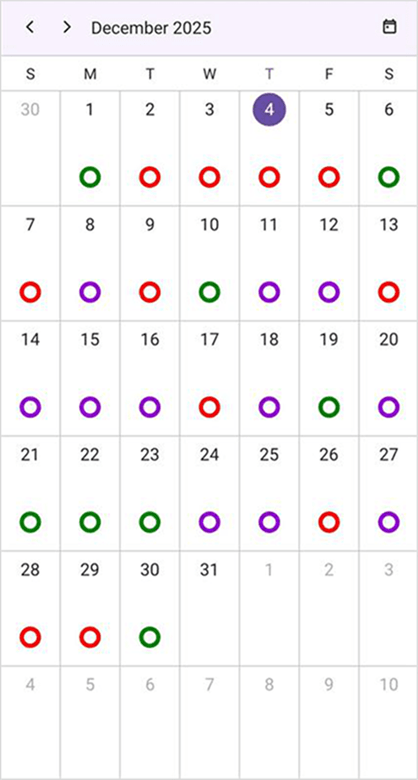
Hide leading and trailing dates
The previous and next month dates from a Scheduler month view can be hidden by using the ShowLeadingAndTrailingDates property in the MonthView. The ShowLeadingAndTrailingDates property defaults to true.
<scheduler:SfScheduler x:Name="Scheduler"
View="Month">
<scheduler:SfScheduler.MonthView>
<scheduler:SchedulerMonthView
ShowLeadingAndTrailingDates="False"/>
</scheduler:SfScheduler.MonthView>
</scheduler:SfScheduler>SfScheduler scheduler = new SfScheduler();
scheduler.View = SchedulerView.Month;
scheduler.MonthView.ShowLeadingAndTrailingDates = false;
this.Content = scheduler;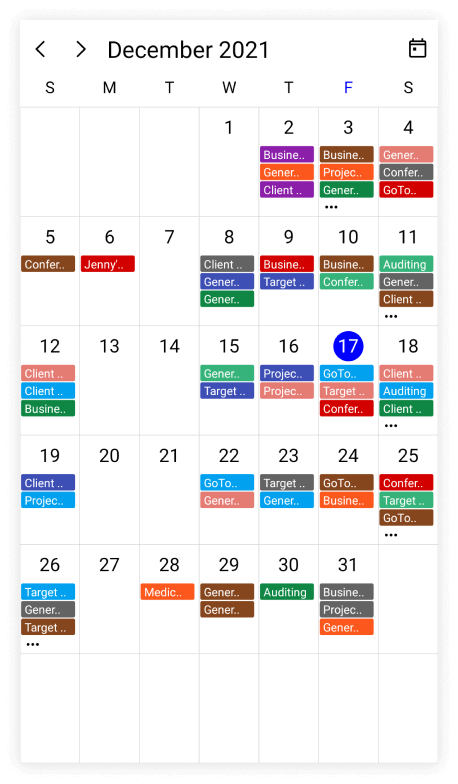
Number of weeks visible in the month view
The number of week visible in the month view can be changed by setting the NumberOfVisibleWeeks property in the MonthView.
<scheduler:SfScheduler x:Name="Scheduler"
View="Month">
<scheduler:SfScheduler.MonthView>
<scheduler:SchedulerMonthView
NumberOfVisibleWeeks="2"/>
</scheduler:SfScheduler.MonthView>
</scheduler:SfScheduler>SfScheduler scheduler = new SfScheduler();
scheduler.View = SchedulerView.Month;
scheduler.MonthView.NumberOfVisibleWeeks = 2;
this.Content = scheduler;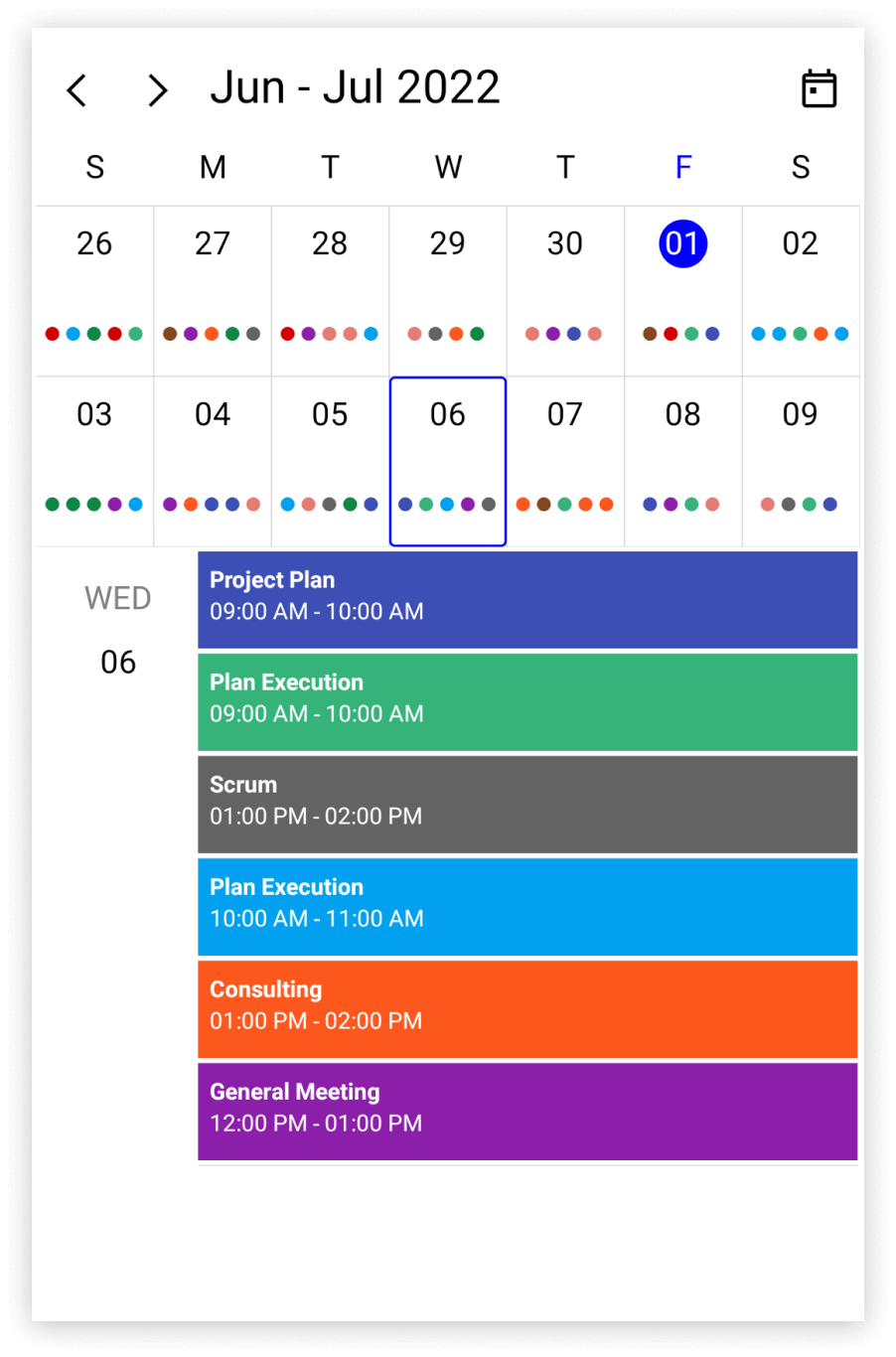
View header
You can customize the default appearance of view header in a month view by setting the DayFormat, DayTextStyle, Background, Height, and ViewHeaderTemplate properties of MonthView in the SfScheduler.
Change day format of view header
Customize the day format of Scheduler view header by using the DayFormat property of ViewHeaderSettings in MonthView.
<scheduler:SfScheduler x:Name="Scheduler"
View="Month">
<scheduler:SfScheduler.MonthView>
<scheduler:SchedulerMonthView>
<scheduler:SchedulerMonthView.ViewHeaderSettings>
<scheduler:SchedulerViewHeaderSettings DayFormat="dddd" />
</scheduler:SchedulerMonthView.ViewHeaderSettings>
</scheduler:SchedulerMonthView>
</scheduler:SfScheduler.MonthView>
</scheduler:SfScheduler>SfScheduler scheduler = new SfScheduler();
scheduler.View = SchedulerView.Month;
scheduler.MonthView.ViewHeaderSettings.DayFormat = "dddd";
this.Content = scheduler;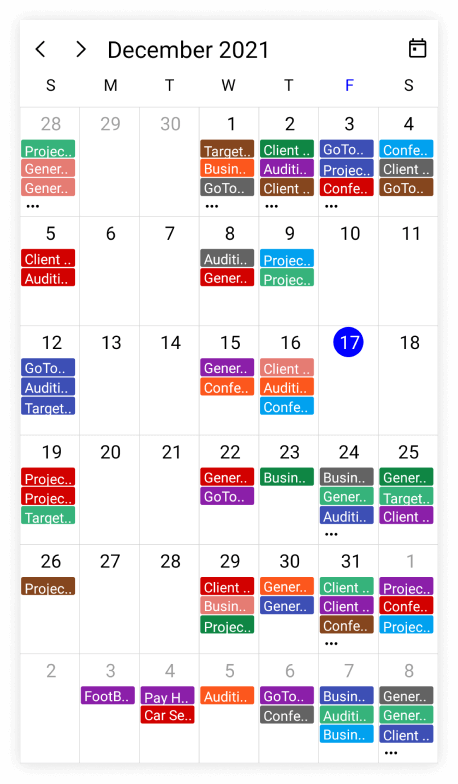
View header height
The height of the ViewHeader can be customized by setting the Height property of ViewHeaderSettings in MonthView.
<scheduler:SfScheduler x:Name="Scheduler"
View="Month">
<scheduler:SfScheduler.MonthView>
<scheduler:SchedulerMonthView>
<scheduler:SchedulerMonthView.ViewHeaderSettings>
<scheduler:SchedulerViewHeaderSettings Height="100" />
</scheduler:SchedulerMonthView.ViewHeaderSettings>
</scheduler:SchedulerMonthView>
</scheduler:SfScheduler.MonthView>
</scheduler:SfScheduler>SfScheduler scheduler = new SfScheduler();
scheduler.View = SchedulerView.Month;
scheduler.MonthView.ViewHeaderSettings.Height = 100;
this.Content = scheduler;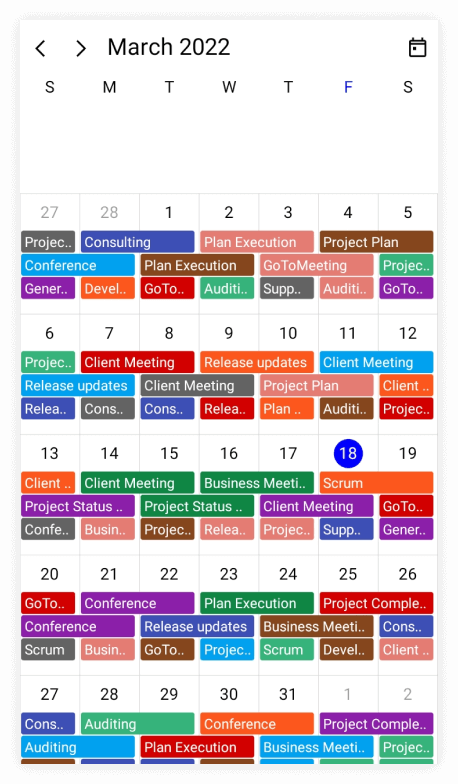
Customize view header appearance
The view header appearance customization can be achieved by using the TextStyle and ViewHeaderTemplate properties of MonthView in the SfScheduler.
Customize view header appearance using text style
Customize the month view header day text style, day format and background color by using the DayTextStyle, DayFormat and Background of ViewHeaderSettings properties of MonthView respectively.
<scheduler:SfScheduler x:Name="Scheduler"
View="Month">
<scheduler:SfScheduler.MonthView>
<scheduler:SchedulerMonthView>
<scheduler:SchedulerMonthView.ViewHeaderSettings>
<scheduler:SchedulerViewHeaderSettings DayFormat="dddd"
Background="LightSkyBlue"/>
</scheduler:SchedulerMonthView.ViewHeaderSettings>
</scheduler:SchedulerMonthView>
</scheduler:SfScheduler.MonthView>
</scheduler:SfScheduler>SfScheduler scheduler = new SfScheduler();
scheduler.View = SchedulerView.Month;
scheduler.MonthView.ViewHeaderSettings.Background = Brush.LightSkyBlue;
scheduler.MonthView.ViewHeaderSettings.DayFormat = "dddd";
this.Content = scheduler;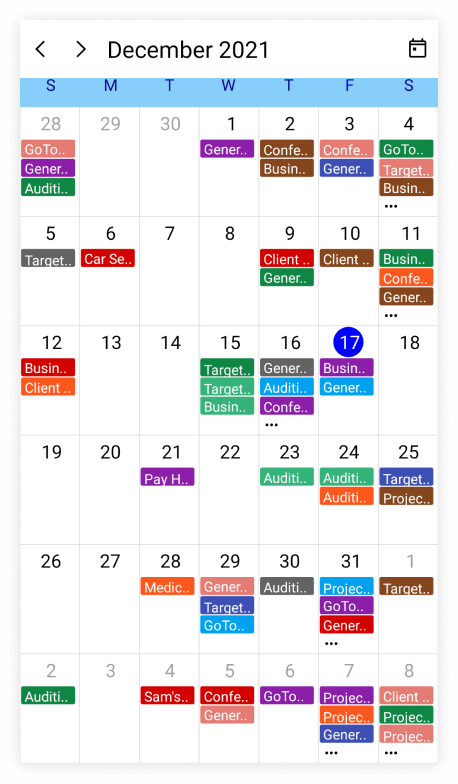
Customize view header appearance using DataTemplate
You can customize the view header appearance by using the ViewHeaderTemplate property of MonthView in the SfScheduler.
<scheduler:SfScheduler x:Name="Scheduler"
View="Month">
<scheduler:SfScheduler.MonthView>
<scheduler:SchedulerMonthView>
<scheduler:SchedulerMonthView.ViewHeaderTemplate>
<DataTemplate>
<Grid Background = "MediumPurple" >
<Label x:Name="label" HorizontalOptions="Center" VerticalOptions="Center" Text="{Binding StringFormat='{0:ddd}'}" TextColor="White" FontSize="Subtitle" FontFamily="Bold" />
</Grid>
</DataTemplate>
</scheduler:SchedulerMonthView.ViewHeaderTemplate>
</scheduler:SchedulerMonthView>
</scheduler:SfScheduler.MonthView>
</scheduler:SfScheduler>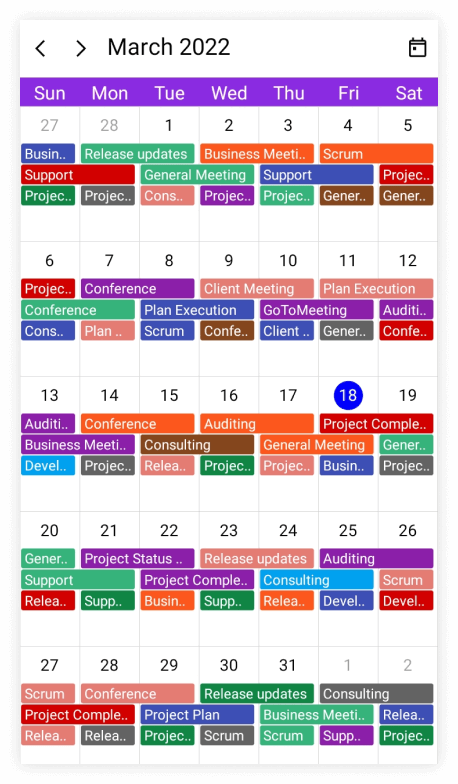
Customize view header appearance using DataTemplateSelector
You can customize the view header appearance by using the ViewHeaderTemplate property of MonthView in the SfScheduler. The DataTemplateSelector can choose a DataTemplate at runtime based on the value of a data-bound to scheduler view header by using the ViewHeaderTemplate. It allows you to choose a different data template for each view header, as well as customize the appearance of a particular view header based on certain conditions.
<Grid>
<Grid.Resources>
<DataTemplate x:Key="normaldatesTemplate">
<Grid Background = "lightBlue">
<Label x:Name="label" HorizontalOptions="Center" VerticalOptions="Center" Text="{Binding StringFormat='{0:ddd}'}" TextColor="Red" />
</Grid>
</DataTemplate>
<DataTemplate x:Key="todayDatesTemplate">
<Grid Background = "LightGreen" >
<Label x:Name="label" HorizontalOptions="Center" VerticalOptions="Center" Text="{Binding StringFormat='{0:ddd}'}" TextColor="Orange" />
</Grid>
</DataTemplate>
<local:MonthViewHeaderTemplateSelector x:Key="monthViewHeaderTemplateSelector" TodayDatesTemplate="{StaticResource todayDatesTemplate}" NormaldatesTemplate="{StaticResource normaldatesTemplate}" />
</Grid.Resources>
<scheduler:SfScheduler x:Name="Scheduler"
View="Month">
<scheduler:SfScheduler.MonthView>
<scheduler:SchedulerMonthView ViewHeaderTemplate = "{StaticResource monthViewHeaderTemplateSelector}"/>
</scheduler:SfScheduler.MonthView>
</scheduler:SfScheduler>
</Grid>public class MonthViewHeaderTemplateSelector : DataTemplateSelector
{
public MonthViewHeaderTemplateSelector()
{
}
public DataTemplate TodayDatesTemplate { get; set; }
public DataTemplate NormaldatesTemplate { get; set; }
protected override DataTemplate OnSelectTemplate(object item, BindableObject container)
{
var viewHeaderDetails = (DateTime)item;
if (viewHeaderDetails.Date.Month == DateTime.Today.Month)
return TodayDatesTemplate;
return NormaldatesTemplate;
}
}NOTE
- When using data template selector, performance issues occur as the conversion template views take time within the framework.
Month Navigation direction
The MonthView of SfScheduler can be navigated in both horizontal and vertical directions. You can change the direction of navigation through the NavigationDirection property of MonthViewSettings in SfScheduler . By default, the navigation direction is Horizontal.
<scheduler:SfScheduler x:Name="schedule" View="Month">
<scheduler:SfScheduler.MonthView >
<scheduler:SchedulerMonthView NavigationDirection="Vertical"/>
</scheduler:SfScheduler.MonthView>
</scheduler:SfScheduler>schedule.MonthView.NavigationDirection = SchedulerMonthNavigationDirection.Vertical;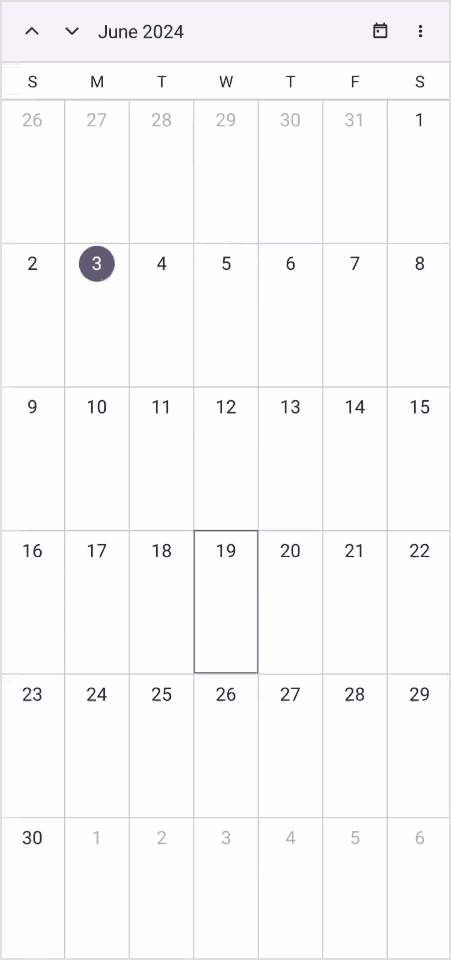
Month cell appearance
The month cell appearance can be customized by using the CellStyle, and CellTemplate properties of MonthView in the SfScheduler.
Customize month cell appearance using text style
By using the CellStyle property of MonthView, the month properties such as Background, TodayBackground, TrailingMonthBackground, LeadingMonthBackground, TextStyle, TrailingMonthTextStyle, and LeadingMonthTextStyle can be customized.
<scheduler:SfScheduler x:Name="Scheduler"
View="Month">
</scheduler:SfScheduler>this.Scheduler.View = SchedulerView.Month;
var textStyle = new SchedulerTextStyle()
{
TextColor = Colors.DarkBlue,
FontSize = 14,
};
var leadingMonthTextStyle = new SchedulerTextStyle()
{
TextColor = Colors.Red,
FontSize = 14,
};
var trailingMonthTextStyle = new SchedulerTextStyle()
{
TextColor = Colors.Red,
FontSize = 14,
};
var monthCellStyle = new SchedulerMonthCellStyle()
{
Background = Brush.LightSkyBlue,
TodayBackground = Brush.LightBlue,
LeadingMonthBackground = Brush.LightGreen,
TrailingMonthBackground = Brush.LightYellow,
TextStyle = textStyle,
LeadingMonthTextStyle = leadingMonthTextStyle,
TrailingMonthTextStyle = trailingMonthTextStyle
};
this.Scheduler.MonthView.CellStyle = monthCellStyle;
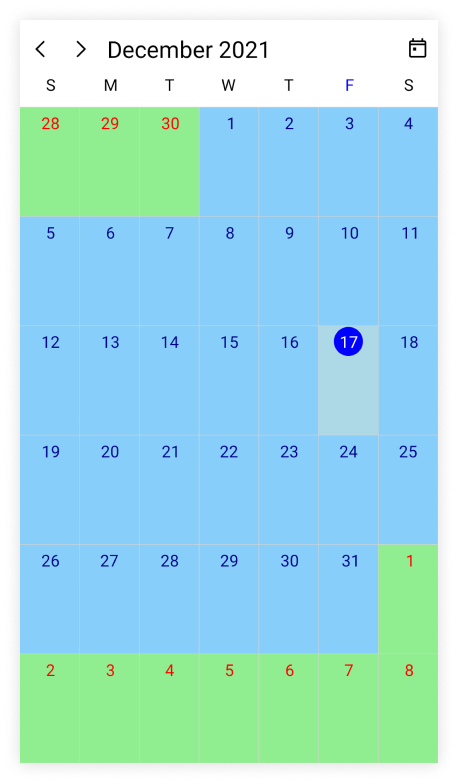
Customize month cell appearance using DataTemplate
You can customize the month cell appearance by using the CellTemplate property of MonthView in the SfScheduler.
<scheduler:SfScheduler x:Name="Scheduler"
View="Month">
<scheduler:SfScheduler.MonthView>
<scheduler:SchedulerMonthView>
<scheduler:SchedulerMonthView.CellTemplate>
<DataTemplate>
<Grid Background = "MediumPurple">
<Label HorizontalTextAlignment="Center" TextColor="White" Text="{Binding DateTime.Day}"/>
</Grid>
</DataTemplate>
</scheduler:SchedulerMonthView.CellTemplate>
</scheduler:SchedulerMonthView>
</scheduler:SfScheduler.MonthView>
</scheduler:SfScheduler>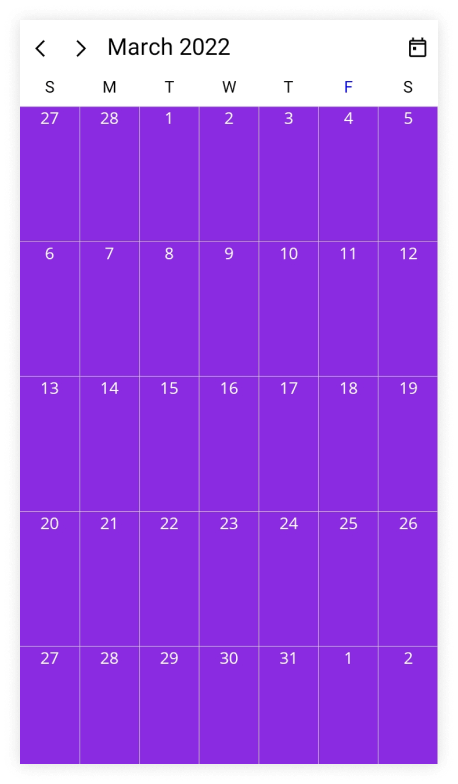
NOTE
- The BindingContext of the
CellTemplateis theSchedulerMonthCellDetails.
Customize month cell appearance using DataTemplateSelector
You can customize the month cell appearance by using the CellTemplate property of MonthView in the SfScheduler. The DataTemplateSelector can choose a DataTemplate at runtime based on the value of a data-bound to scheduler month cells by using the CellTemplate. It allows you to choose a different data template for each month cell, as well as customize the appearance of a particular month cell based on certain conditions.
<Grid>
<Grid.Resources>
<DataTemplate x:Key="normalDateTemplate">
<Grid Background = "MediumPurple">
<Label HorizontalTextAlignment="Center" TextColor="White" Text="{Binding DateTime.Day}"/>
</Grid>
</DataTemplate>
<DataTemplate x:Key="todayDateTemplate">
<Grid Background = "MediumPurple">
<Label HorizontalTextAlignment="Center" TextColor="Yellow" Text="{Binding DateTime.Day}"/>
</Grid>
</DataTemplate>
<local:MonthCellTemplateSelector x:Key="monthCellTemplateSelector" TodayDateTemplate="{StaticResource todayDateTemplate}" NormalDateTemplate="{StaticResource normalDateTemplate}"/>
</Grid.Resources>
<scheduler:SfScheduler x:Name="Scheduler"
View="Month" >
<scheduler:SfScheduler.MonthView>
<scheduler:SchedulerMonthView CellTemplate="{StaticResource monthCellTemplateSelector}" />
</scheduler:SfScheduler.MonthView>
</scheduler:SfScheduler>
</Grid>public class MonthCellTemplateSelector : DataTemplateSelector
{
public MonthCellTemplateSelector()
{
}
public DataTemplate NormalDateTemplate { get; set; }
public DataTemplate TodayDateTemplate { get; set; }
protected override DataTemplate OnSelectTemplate(object item, BindableObject container)
{
var monthCellDetails = item as SchedulerMonthCellDetails;
if (monthCellDetails.DateTime.Date == DateTime.Today.Date)
return TodayDateTemplate;
else
return NormalDateTemplate;
}
}this.Scheduler.View = SchedulerView.Month;NOTE
- The BindingContext of the
CellTemplateis theSchedulerMonthCellDetails.- When using data template selector, performance issues occur as the conversion template views take time within the framework.